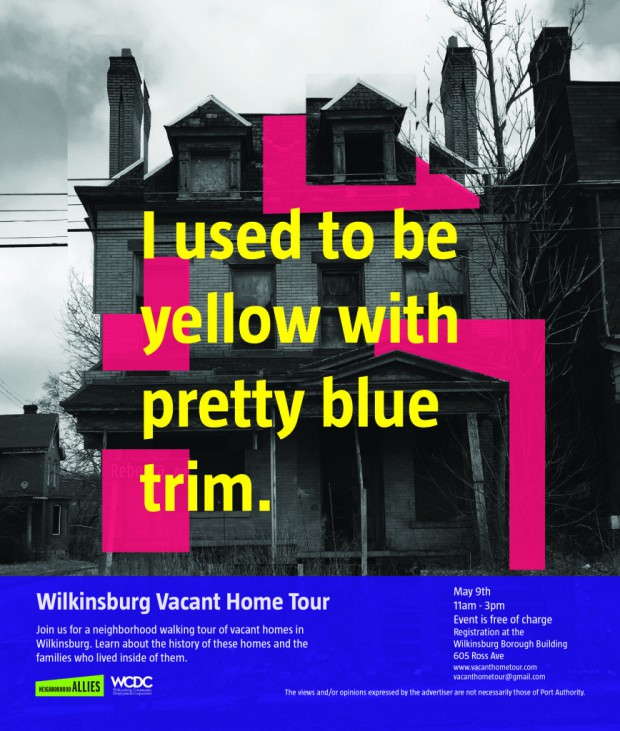This Saturday, May 9th, is the Vacant Home Tour of Wilkinsburg. Tour takers will spend 45 minutes walking through Wilkinsburg, be shown five vacant historic homes by knowledgeable tour guides, then be able to sit in on a workshop to learn what goes into buying one. If you’re thinking “that sounds unique”, you’re right: it may be the first tour of its kind. And if you’re thinking “I should go”, then you’re not alone: nearly 500 people have RSVP’d on their Facebook page. Best of all, the tour is free for you to take because of a Small & Simple Grant from Neighborhood Allies, additional funding from the Fels Challenge and Carnegie Mellon University, and residents generous enough to volunteer as guides.
Vacant Home Tour Preview from Wilkinsburg CDC on Vimeo.
Five Carnegie Mellon University students were exploring ways of highlighting and alleviating urban blight when they came up with the idea for a vacant home tour. Kenneth Chu, a student in Public Policy and Management at the Heinz College, spoke on WESA this week about working with students in other programs including design and human-computer interaction during the semester long class. Knowing that they wanted to deal with urban blight, their research and personal connections led them to Wilkinsburg, where they worked with the Wilkinsburg Community Development Corporation (WCDC) and local residents to develop the program. The resulting proposal for a Vacant Home Tour won a cash award from the Fels Challenge, a national public policy competition.

Planning for the Wilkinsburg Vacant Home Tour
Ultimately, the designers of the tour want the people who take it not to see the vacant homes as blight, but as a possible home or an investment opportunity. To help change perceptions, docents at each of the five homes will be on hand to talk about the history of these properties. The houses were chosen without knowledge of their histories and residences have pieced together their histories through online records, physical archives and good old-fashioned oral history. Marlee Gallagher, Communications & Outreach Coordinator at the WCDC, says, “I do think that having the historical background increases the value by adding emotion and humanity to an otherwise vacant, blighted, inanimate object.” She’s seeking to capitalize on a growing trend of wanting to know the history of your home, something that cannot be maintained if you demolish and start over.
The task of restoring these homes will be difficult; in their current condition, they can only be viewed from the outside due to safety concerns. But it is not impossible. The neighborhood of Wilkinsburg has been looking for ways to deal with blight since the collapse of the steel industry. One such effort began in 2005 when Pittsburgh History and Landmarks Foundation (PHLF) conducted a survey of vacant properties in Wilkinsburg, concluding a year later that about 70% of the housing stock could be restored rather than torn down. But PHLF does not have the resources to restore all of the properties on it’s own. Karamagi Rujumba, Director of Public Communications and Advocacy at PHLF, told me that “we cannot do all the work; we can only be leaders”. By way of leading by example, PHLF acquired a former auto repair shop at the nexus of Hamnett place. They restored that property and opened the Landmarks Preservation Resource Center in 2010, a program that serves to educate community members on how to restore, maintain and preserve their homes. They attract people from Wilkinsburg, the greater Pittsburgh area, and even as far as Ohio and West Virginia to take their workshops. They offer lectures and film screenings as well as popular hands-on carpentry and masonry workshops where people can see firsthand how to do the hard work of restoring a home. The final stop on the tour will be the LRPC where they will be offering a workshop for people who might be interested in acquiring a vacant home.
The project is poised for success. It has received international attention (Brussels has asked what’s up) and people are responding to the subversion of the typical home and garden tour, and uniquely honest approach of highlighting blight rather than hiding it. The [Your Neighborhood Here] Vacant Home Tour is about to become a thing, and you can still be a part of the very first one on Saturday May 9.
The tour is free to attend. RSVP on Facebook here.


